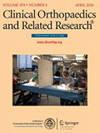What Factors Are Associated With Implant Revision in the Treatment of Pathologic Subtrochanteric Femur Fractures?
IF 4.2
2区 医学
Q1 ORTHOPEDICS
引用次数: 0
Abstract
BACKGROUND Limiting reoperation or revision after operative stabilization or endoprosthetic reconstruction of a pathologic subtrochanteric femur fracture reduces morbidity, but how best to achieve this remains controversial. Endoprosthetic reconstruction offers durable mechanical stability but may not be most appropriate in patients who are frail or who are not expected to survive more than a few months. For that reason, cumulative incidence survival (looking at the endpoint of reoperation or revision with death as a competing risk) and factors associated with revision after surgical stabilization or reconstruction-both of which remain poorly characterized to date-would help surgeons make better decisions on behalf of these patients. QUESTIONS/PURPOSES We analyzed patients who were operatively treated for pathologic subtrochanteric femur fracture, and we asked: (1) What is the cumulative incidence of reoperation and revision at 3 months, 1 year, and 2 years after surgery for pathologic subtrochanteric femur fracture in patients undergoing each treatment type with death as a competing risk? (2) What are the factors associated with implant revision after operative treatment of pathologic subtrochanteric femur fracture? (3) What is the overall survival of patients in this population after surgery? (4) How do clinical and surgical factors along with the frequency of complications compare in this population by operative treatment? METHODS Between January 2000 and December 2020, 422 patients underwent surgery for completed proximal femur pathologic fractures. After excluding patients with non-subtrochanteric femur fractures (71% [301]), fractures caused by primary tumors of bone (< 1% [2]), and insufficient data (1% [6]), we included 113 patients who underwent operative treatment of completed pathologic subtrochanteric femur fractures. Our study period spanned 20 years because although implant trends may have shifted, the overall operative objective for pathologic subtrochanteric femur fractures-restoring function and alleviating pain, regardless of the extent of bony union-have remained relatively unchanged during this period. Median follow-up time was 6 months (range 1 month to 20.6 years). Intramedullary nailing (IMN) was performed in 68% (77) of patients, proximal femur replacement (PFR) was performed in 19% (22), and open reduction and internal fixation (ORIF) was performed in 12% (14) of patients. IMN was performed in patients with a poor prognosis but in whom fracture stabilization was felt to be advantageous. In instances of complex fractures in which adequate reduction could not be achieved, ORIF was generally performed. PFR was generally performed in patients with a better prognosis in which long-term implant survival and patient function were prioritized. We found a higher proportion of women in the IMN group (73% versus 32% in PFR and 50% in ORIF; p = 0.001). Rapid growth tumors (Katagiri classification) were found in 25% of patients with IMN, 27% with PFR, and 43% with ORIF. The primary outcome was the cumulative incidence of reoperation or revision surgery after initial stabilization. Competing risk analysis with death as a competing event was performed to estimate the cumulative incidence for reoperation and revision. Factors associated with revision surgery were identified using the Cox proportional hazards model, which rendered HRs. All analyses were adjusted to control for potential confounders. RESULTS The cumulative incidence for reoperation at 2 years was 5% (95% confidence interval [CI] 4% to 6%) for IMN, 15% (95% CI 9% to 22%) for PFR, and 32% (95% CI 15% to 50%) for ORIF (p = 0.03). The cumulative incidence for revision at 2 years was 4% (95% CI 3% to 4%) for IMN, 4% (95% CI 2% to 6%) for PFR, and 33% (95% CI 15% to 51%) for ORIF (p = 0.01). Factors associated with revision surgery were radioresistant tumor histology (HR 8.5 [95% CI 1.2 to 58.9]; p = 0.03) and ORIF (HR 6.3 [95% CI 1.5 to 27.0]; p = 0.01). The 3-month, 1-year, and 2-year overall survival was 80% (95% CI 71% to 87%), 35% (95% CI 26% to 45%), and 28% (95% CI 19% to 36%), respectively. Thirty-day postoperative complications did not differ by fixation type, but 90-day readmission was highest after ORIF (3 of 14 versus 4 of 22 in PFR and 4% [3 of 77] in IMN; p = 0.03) Periprosthetic joint infection (PJI) was more common after salvage PFR (2 of 6) than primary PFR (1 of 22) (p = 0.04). CONCLUSION Primary PFR may be preferred for pathologic subtrochanteric femur fractures arising from radioresistant tumor types, as the cumulative incidence of revision was no different than for IMN while restoring function, alleviating pain, and offering local tumor control, and it less commonly develops PJI than salvage PFR. In complex fractures not amenable to IMN, surgeons should consider performing a PFR over ORIF because of the lower risk of revision and the added benefit of replacing the pathologic fracture altogether and offering immediate mechanical stability with a cemented endoprosthesis. Future studies might evaluate the extent of bone loss from local tumor burden, and this could be quantified and analyzed in future studies as a covariate as it may clarify when PFR is advantageous in this population. LEVEL OF EVIDENCE Level III, therapeutic study.在治疗病理性股骨转子下骨折时,哪些因素与植入物翻修有关?
对于不适合使用 IMN 的复杂骨折,外科医生应考虑实施 PFR,而不是 ORIF,因为翻修风险较低,而且还能完全取代病理骨折,并通过骨水泥内假体提供即时的机械稳定性。未来的研究可能会评估局部肿瘤负担造成的骨质流失程度,这可以在未来的研究中作为一个协变量进行量化和分析,因为这可能会明确PFR在这一人群中的优势。
本文章由计算机程序翻译,如有差异,请以英文原文为准。
求助全文
约1分钟内获得全文
求助全文
来源期刊
CiteScore
7.00
自引率
11.90%
发文量
722
审稿时长
2.5 months
期刊介绍:
Clinical Orthopaedics and Related Research® is a leading peer-reviewed journal devoted to the dissemination of new and important orthopaedic knowledge.
CORR® brings readers the latest clinical and basic research, along with columns, commentaries, and interviews with authors.

 求助内容:
求助内容: 应助结果提醒方式:
应助结果提醒方式:


